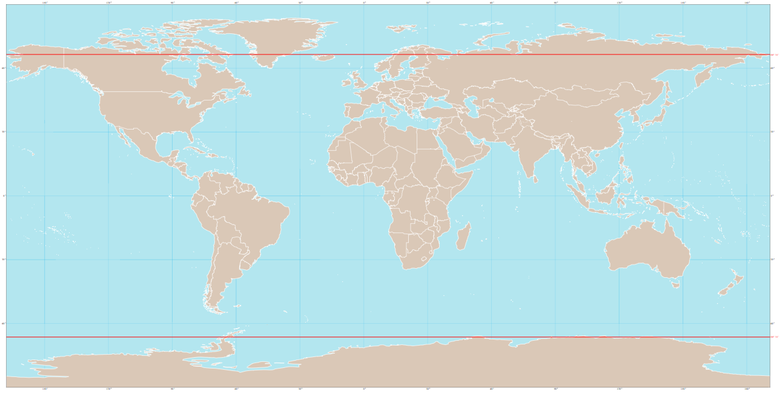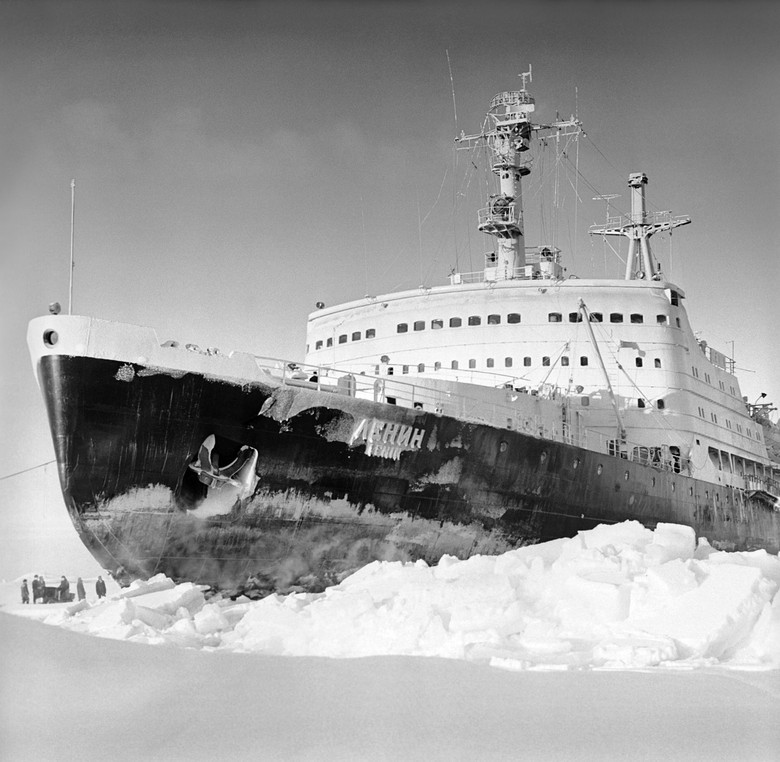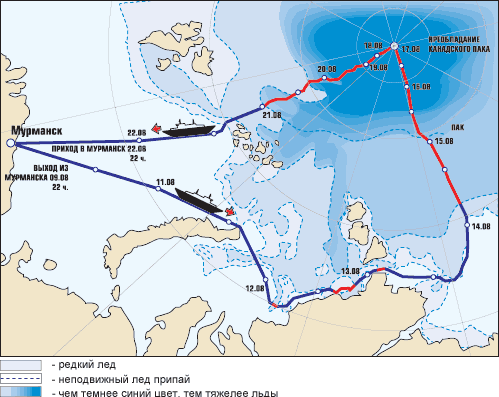Peace atom breaks ice: our atomic icebreaking fleet

59 years ago, on December 5, 1957, the world's first surface vessel launched by a nuclear reactor — the nuclear-powered icebreaker Lenin — descended from the stocks. The history of the Russian atomic icebreaking fleet began from this ship, which carried out ships for 30 years in the Arctic Ocean. Russia is the only country in the world that builds and uses nuclear-powered icebreakers.
An icebreaker is a ship designed to lay a passage in the ice for ordinary ships. Also icebreakers are used to solve research problems in the Arctic and Antarctic latitudes. These vessels have a high-strength hull, in which the bow (and in some icebreakers - and the stern) part has a special shape, allowing not only to break the ice like a battering ram, but also to push it under its weight.
The history of icebreakers dates back to the middle of the 19th century. For several decades, they were used for walking on frozen rivers and sea bays. And the first Arctic icebreaker in the world was the Yermak , built for the Russian Empire in England in 1898, and served until 1963.
')

The higher the mass of the icebreaker and the power of its power plant, the greater the thickness of the ice it is able to break through. To work in the waters of the North and South Poles of the planet, where the seas are covered with solid ice several meters thick, we need fairly large and powerful vessels. Only a few countries use icebreakers capable of walking in high latitudes, due to their geographical location. And in this respect, Russia is unique - all of our northern coast of vast extent is located beyond the Arctic Circle and is washed by the waters of the Arctic Ocean.

The red lines are the north and south polar circles.

My native land is wide: our northern borders stretch from the western edge of the Barents Sea to the middle of the Chukchi Sea. Almost half the circumference.
Our ancestors need to thank for the fact that they have expanded the borders of the state from Europe to North America. This gave us huge reserves of minerals that many times saved our country in wars and economic cataclysms. For example, the Norilsk Mining and Metallurgical Combine during the war was the main supplier of a strategically important resource - nickel. Today on the northern coast and in the mouths of the Ob and Yenisei rivers there are a number of cities, ports and settlements that are crucial for the supply of numerous hard-to-reach towns and villages. Oil, gas, metals and many other valuable resources are exported through the ports on the north coast. Moreover, the shortest route from Europe to the Far East goes along our polar borders. It is called the Northern Sea Route (NSR).

The blue line is the Northern Sea Route.
It is thanks to the NSR there are numerous settlements and enterprises in the vast northern expanses. In some cities and towns can only be reached in two ways: by plane or by sea. But there is one problem: most of the year the NSR is covered with ice. And not so, which on the rivers and ponds are drilled by fans of winter fishing. Everything is more than serious here - this is the Arctic. The thickness of the ice can reach 4 meters or more. So without the most powerful icebreakers simply can not do.
The first icebreakers were steam, working on coal. But it was a very inefficient fuel: the ships were forced to carry huge reserves of coal, and still had to often go to the ports and replenished. The need to increase power and increase autonomy led to the creation of diesel icebreakers. But the severe ice, the gigantic extent of the Northern Sea Route and a small number of ports required the creation of even more powerful vessels capable of breaking the thicker ice and operating for long months without refueling.
So appeared "Lenin".
"Lenin"
Only 12 years after the end of the war, the USSR was able to launch an artificial satellite into orbit for the first time in the world. It happened on October 4, 1957. And almost exactly two months later the hull of the icebreaker "Lenin" was launched. It was not only the first nuclear surface ship, but also the first nuclear civilian (three years before the Americans had released the first nuclear submarine "Nautilus" into the ocean).
Lenin was a model of advanced technology, one of the achievements of science and industry of the Soviet Union: the length is 134 m, the displacement is 16 thousand tons, the power on the rowing shafts reached 32 MW. For comparison: the US coast guard icebreaker Glacier , which was one of the largest in the world at that time, was 94 meters long, had a displacement of 8.5 thousand tons, and had a capacity of only 16 MW. The ballast tank system on the Lenin made it possible to change the vessel's roll, swinging it from side to side, if there was a threat of rubbing ice off the sides.




The first atomic meets the first Arctic - "Lenin" and "Ermak":




From 1967 to 1970, "Lenin" was being upgraded - three reactors with a capacity of 90 MW each were replaced by two 159 MW each. It looked like a power plant with three reactors:

The modernization was carried out because the first reactors installed on Lenin were very unreliable . In 1965, an accident occurred, which also demonstrated the low maintainability of the power plant of the icebreaker. Therefore, the old reactors were removed ... just by cutting a hole in the body and dropping them to the bottom.

The icebreaker became a real locomotive of the Northern Sea Route: it conducted through the ice and rescued numerous cargo ships from ice captivity, participated in scientific expeditions. Thanks to the commissioning of such an unprecedented powerful icebreaker, capable of crushing ice that was too tough for its diesel predecessors, it was possible to significantly lengthen the navigation period on the NSR and increase the overall traffic flow.


Dosimetrists check icebreaker reactors:


For three decades of its service, “Lenin” conducted 3,741 ships, traveled 654,000 miles, of which 563,000 were in the ice. In 1989, the firstborn of a nuclear surface fleet was decommissioned, and in the 2000s a museum appeared there. If you travel in sunny Murmansk, you can visit Lenin with a guided tour.

Icebreakers class "Arctic"

For a long time, "Lenin" was the only atomic icebreaker. And in 1975, the more powerful ship of the project 1052, the Arctic , was commissioned (from 1982 to 1986, it was named Leonid Brezhnev). With a length of 148 meters and a displacement of 23,460 tons, it has become the largest icebreaker in the world. Two reactors with a capacity of 171 MW each powered steam generating plants providing up to 49 MW of power to the propeller shafts. The icebreaker could cross the ice up to 2.8 m thick. The autonomy of the voyage — not on nuclear fuel, but on provisions — was 7.5 months.



The thickness of the outer hull of the icebreaker in the most loaded areas reached 48 mm. The Arctic also had a ballast tank system, which allowed changing both the list and the trim of the ship, which increased the crushing efficiency of the thick ice and did not let the icebreaker get stuck. This icebreaker could break the ice not only with the nose, but also astern.


The Arctic became the lead ship in the most massive series of our nuclear-powered icebreakers. A total of 6 such ships were built. Despite purely peaceful tasks, the project 1052/10521 implied the possibility of quickly equipping icebreakers with armaments, turning them into auxiliary cruisers.

In 1977, the "Arctic" became the first ship in the world, which under its own power (without drifting) reached the North Pole . It seems to us, amateurs, something ordinary: think, an icebreaker, in fact, laid a course on the line and flooded the ice to break to the very top of the planet. But even for the most powerful icebreaker of that time, this was a very difficult task: the huge hummocks, current and wind could break the cone of one of the screws, which would immediately reduce the icebreaker’s capacity by a third. To avoid this, the route to the North Pole was laid in areas where, according to observation statistics, the probability of powerful ice movements was the least.

The hike was successful, and on August 17, 1977 the icebreaker "Arktika" arrived at a point with the coordinates of 90 ° north latitude and 0 ° east longitude. During the hike, the high running performance of the new atomic icebreaker was confirmed, numerous data were collected on the behavior of the ship hull in various driving conditions under crushing especially thick ice, equipment for remotely determining ice thickness was tested for the first time, a satellite navigation system was tested at high latitudes, and so on .

In 2008, the icebreaker "Arktika" was decommissioned due to technical and moral obsolescence. Now he is waiting for his turn for recycling.

As mentioned above, the project 1052 ships were the most massive in our atomic icebreaking fleet. In addition to the "Arctic" were built:
- Siberia , commissioned in 1977. After the "Arctic", he became the second in the world surface ship, independently reached the North Pole (May 25, 1987). He served in the northern seas until 1993, and then was mothballed. Siberia was the first nuclear-powered icebreaker sent for recycling.

- "Russia" , put into operation in 1985. Built on the upgraded project 10521.





It has already been mentioned above that the icebreakers of the Arctic project could be quickly converted into auxiliary cruisers. The composition of the weapons would be as follows:- Radar " Frigate ".
- Two AK-100 artillery mounts.
- Four anti-aircraft six-barreled artillery installations AK-630 .
- Complex electronic suppression PC-2 .
During the sea trials on the "Russia" was mounted the entire set of weapons. At the end of the test, the icebreaker again "fenced":
In 2013, the icebreaker was decommissioned and is laid up. - "Soviet Union" , was commissioned in 1990. An artillery fire control radar is mounted on the tank (gray cylinder before chopping).

The icebreaker has worked for only 20 years: since 2010 it has been in sludge. There are plans to extend its resource and re-commissioning. - Yamal , commissioned in 1993. The oldest of the existing icebreakers of the project "Arctic". The housing of "Yamal" is covered with a special wear-resistant paint with a reduced friction coefficient.

In this picture you can clearly see how the icebreaker copes with thick ice: thanks to the gentle, sloping hull, the ship leaves on the ice and breaks it with its weight.

In floating dock for repairs:
- "50 Years of Victory" . The youngest of the "Arctic" class icebreakers was launched in 1993, but due to lack of money it was completed and put into operation only in 2007. Today it is the most powerful icebreaker in the world - length 159 m, displacement 23 439 tons. But soon another ship will rise on the pedestal of the “largest and most powerful” (see below).



“50 Years of Victory” is 10 meters longer than the rest of the Arctic class icebreakers thanks to an additional compartment. It contains the disposal systems for all waste of the crew and passengers. That is, the ship uses a closed cycle of recycling waste that does not fall into the ocean.
To reduce friction about ice, a pneumatic wash system is used: in the lower part of the hull, under the waterline, a number of holes pass through which air is forced under high pressure. In this picture you can see them on both sides of the stem:
And metal ovals are ice-resistant platinum-niobium anodes, which reduce the corrosion of the ship's ice belt.


In 2013, 50 Years of Victory brought the Olympic Flame to the North Pole:
Icebreakers class "Taimyr"

For all its power, the Arctic class icebreakers have one feature — a rather large draft. Because of this, they can not enter the mouths of rivers such as the Ob and Yenisei. And this is necessary for carrying cargo ships from the "big water" to a number of northern ports, oil terminals and liquefied natural gas terminals.
Therefore, in 1988 and 1989, by order of the Soviet Union, two small-sitting icebreakers were built in Finland. Then they were towed to Leningrad, where power plants were installed on them and completed. Icebreakers were named "Taimyr" and "Vaigach".


Their length - 151 m, displacement - 20 000 tons. The draft is 8.1 m, three meters less than that of the Arctic class icebreakers. The power of the "Taimyr" and "Vaigach" is also smaller, 32.5 MW on the shafts, so they are able to overcome the ice only up to 2 meters thick.


Likhterovoz "Sevmorput"
In 1988, the nuclear light carrier “Sevmorput” was put into operation. This ship is designed to carry goods in containers and lighters . Although not an icebreaker in the classical sense, however, Sevmporput may well make its way through ice up to 1 m thick.

By the way, it is twice the size of the Arctic-class icebreakers: the length is 260 m, the displacement is 61 880 tons.

It was planned to build a second lighter carrier, but the collapse of the USSR put a cross on these plans. In 2007, Sevmorput was decommissioned and decommissioned. But later it was restored, and in 2016 it was again commissioned. Quite a clear illustration of the thesis about the revival of the Russian North.
By the "Northern Sea Route" moored icebreaker "Captain Nikolaev":

Today, Sevmorput is the only cargo ship in the world with a nuclear power plant.
New "Arctic" and new plans
It would be a mistake to assume that the icebreakers of the project "Arctic" - the Soviet development - is the peak of the development of our nuclear icebreaker fleet. Fortunately, despite all the political and economic difficulties, the development of the Northern Sea Route continues. Moreover, the four currently operating nuclear-powered icebreakers today are loaded with work to the eyeballs - they drive ships for almost 10 months a year.
Besides, everything ever breaks. Icebreakers are not forever, the resource of today's nuclear-powered icebreakers for the most part has already been developed. Therefore, several years ago it was decided to develop a draft of the new icebreaker. They became the project 22220 (class LC-60Ya), the lead ship of which will bear the name "Arctic" - the heir to the "Arctic" 1052/10521. This year the hull of the leading icebreaker was launched:
It will be the largest and most powerful icebreaker in the world. Here are its parameters in comparison with the parameters of “50 Years of Victory”, which is today considered “the most-most”: length 173 m (159 m), displacement 33 540 tons (23 439 tons), shaft power - 60 MW (49 MW) . This will allow him to overcome the ice thickness of 3 meters.



Moreover, the project 22220 icebreakers will replace both the “main” Arctic-class icebreakers and the small-sitting Taimyr class. Thanks to the ballast tank system, they will be able to change their draft from 8.5 m to 10.5 m. Therefore, new icebreakers are called “two-draft”.

The parent “Arctic” is scheduled to be commissioned in 2017. The construction of the second icebreaker of project 22220 - “Siberia” (commissioning in 2019) is underway. An order was placed for the third - “Ural” (commissioning in 2020).
Moreover, changes in the global economy require year-round navigation throughout the Northern Sea Route. With all their power, even icebreakers of the project 22220 are not capable of this, since for 2-3 months a year the thickness of ice may exceed their capabilities. Therefore, today an even more powerful icebreaker of the class LC-110Ya is being designed: with a shaft power of up to 110 MW and with the possibility of overcoming the ice thickness of up to 4 m
As you understand, they will be even bigger, heavier and wider (40 m). The latter is especially important since the width of the icebreaker determines the width of the ships that can follow it. Modern large tankers on the Northern Sea Route require two icebreakers at once, providing a fairly wide passage. The promising LC-110Ya will be able to conduct fairly large ships alone. Although its width will not be enough for cargo ships with a width of about 50 m.
True, wait for the construction of this monster for a long time: with the most optimistic forecasts, not earlier than 2025. To date, such images of the promising super icebreaker are available :

Source: https://habr.com/ru/post/399831/
All Articles